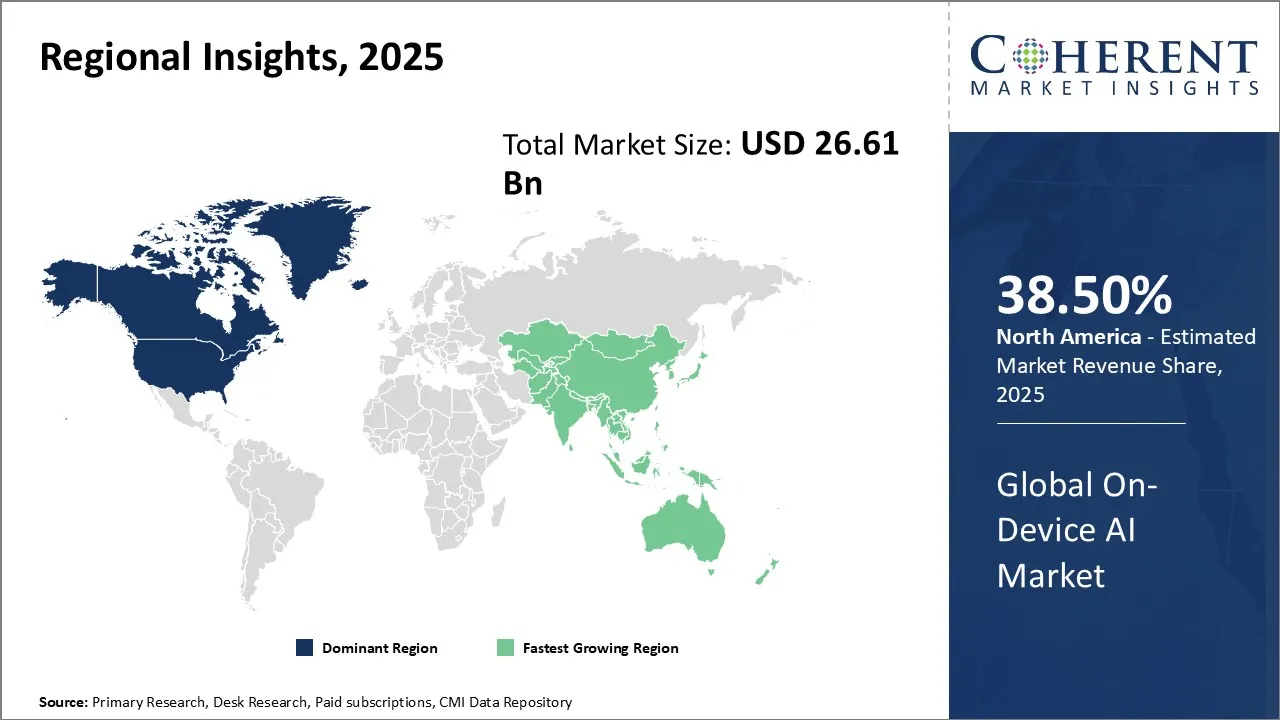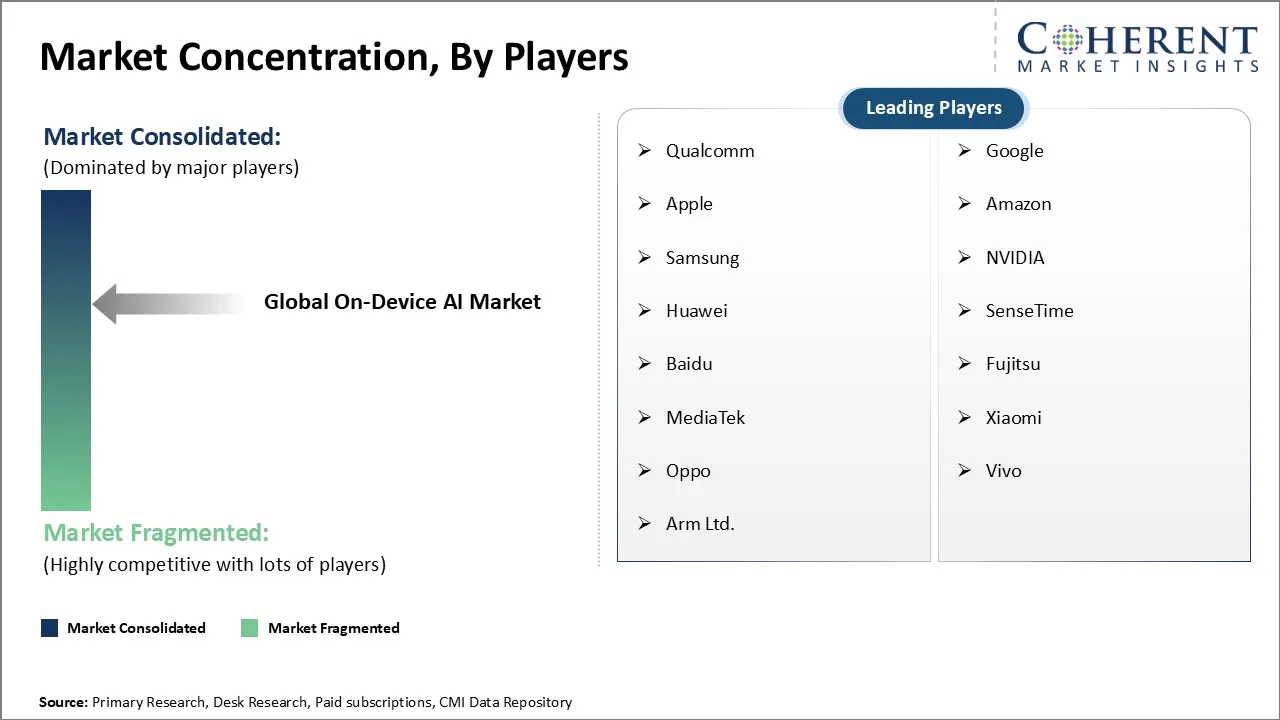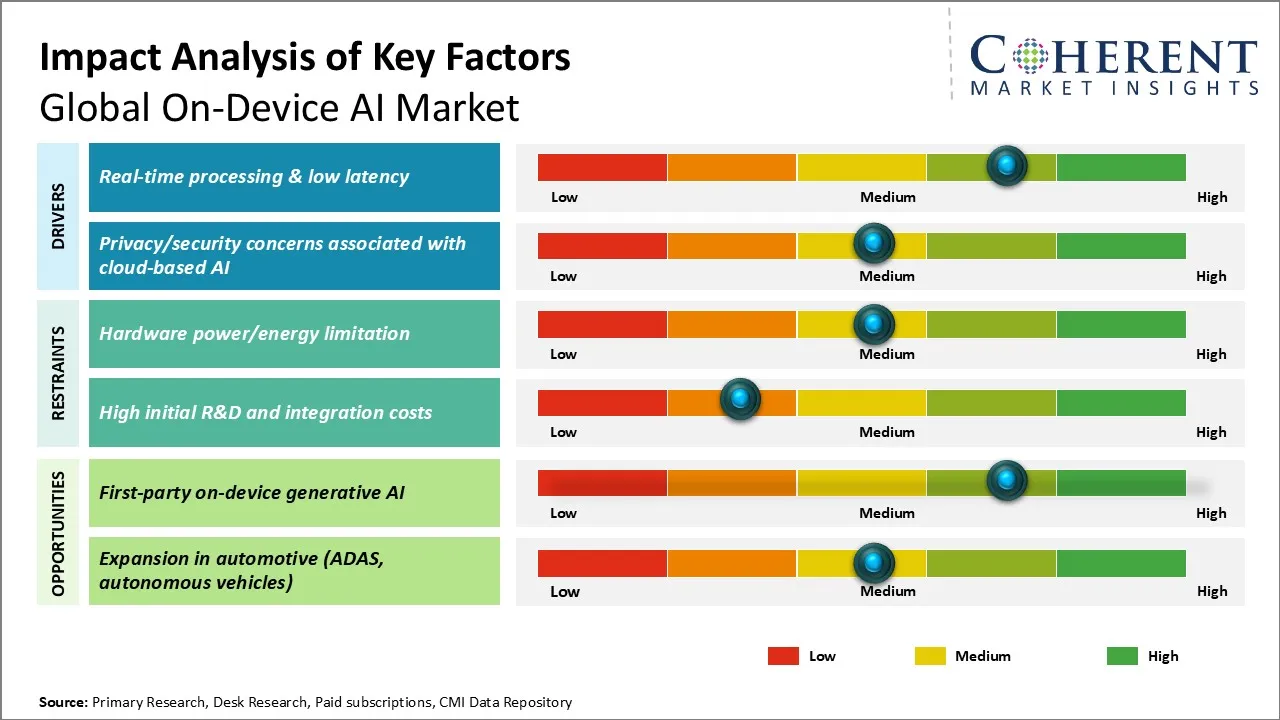Global On-Device AI Market Size and Forecast – 2025-2032
The Global On-Device AI Market is estimated to be valued at USD 26.61 billion in 2025 and is expected to reach USD 124.07 billion by 2032, growing at a compound annual growth rate (CAGR) of 24.6% from 2025 to 2032.
Key Takeaways of the Remote Work Security Market:
- The smartphones segment leads the market, holding an estimated share of 46. 2% in 2025.
- North America is estimated to lead the market with a share of 34. 5% in 2025.
- Asia Pacific, holding a share of 34. 6% in 2025, is projected to be the fastest growing region.
- Real-time processing & low latency and privacy/security concerns associated with cloud-based AI are the major drivers for the market
Market Overview:
The on-device AI market is seeing many trends, such as the high adoption of AI-enabled smartphones and smart devices, advancement in neural processing units (NPUs), and growing emphasis on data privacy regulations. Key market drivers include the rising adoption of voice assistants, computer vision applications, and predictive analytics at the edge. Also, enterprises are opting for on-device processing to minimize cloud dependency, reduce operational costs, and ensure real-time decision-making capabilities in industrial automation.
Current Events and their Impact:
|
Current Events |
Description and its impact |
|
Geopolitical Tensions and Trade Policies |
|
|
Technological Advancements and Innovations |
|
Uncover macros and micros vetted on 75+ parameters: Get instant access to report
Global On-Device AI Market Insights, By Device Type – Smartphones Lead On-Device AI Adoption Through Superior Processing Power and Ubiquitous Consumer Integration
Smartphones are estimated to contribute the highest share of 46.2% in the market in 2025. Smartphones have sophisticated hardware architecture, including dedicated neural processing units (NPUs) and powerful system-on-chip (SoC) designs that make possible efficient AI computations without compromising device performance. Modern smartphones incorporate specialized AI accelerators from leading chipset manufacturers, allowing complex machine learning algorithms to run locally while maintaining optimal battery life and processing speed.
Consumer demand for improved smartphone experiences results in continuous innovation in on-device AI capabilities. Users increasingly expect intelligent features such as computational photography, real-time language translation, voice assistants, and predictive text input that respond instantaneously without internet connectivity. This demand compels manufacturers to integrate more sophisticated AI processing capabilities directly into smartphone hardware.
Privacy concerns significantly boost smartphone on-device AI adoption, as users become more conscious about data security and personal information protection. Processing sensitive data locally on smartphones eliminates the need to transmit personal information to cloud servers, addressing growing privacy apprehensions while maintaining functionality. Features like facial recognition, biometric authentication, and personal assistant interactions benefit substantially from this local processing approach.
End User Feedback & Unmet Needs
- Users often find multi-factor authentication (MFA) and VPNs intrusive or time-consuming, especially when switching between devices or networks. They are looking for solutions that balance security with seamless user experience (e.g., biometric or adaptive security models).
- Employees frequently use a mix of personal and corporate devices (BYOD). Inconsistent security controls across devices lead to vulnerabilities. Manufacturers should work on offering cross-platform endpoint protection that maintains uniform policies across desktops, smartphones, and tablets.
- In 2020, a remote social engineering attack led to access to Twitter's internal tools, resulting in the high-profile hacking of celebrity accounts (e.g., Elon Musk, Barack Obama). This indicates a need for stronger user behavior analytics and internal access controls for remote administrative functions.
Regional Insights:

To learn more about this report, Download Free Sample
North America On-Device AI Market Analysis and Trends
North America, holding a share of 38.5% in 2025, is expected to dominate the on-device AI market. The region benefits from a mature semiconductor ecosystem, advanced manufacturing capabilities, and strong collaboration between academia and industry. Silicon Valley continues to serve as the global epicenter for AI innovation, fostering an environment where startups and established companies alike can thrive.
Key players driving North American dominance include Apple, which has revolutionized on-device AI through its Neural Engine processors and Core ML framework. The company's commitment to privacy-first AI processing has set industry standards. Google's Edge TPU and TensorFlow Lite have democratized on-device AI deployment across various applications. Intel's Movidius and OpenVINO toolkits have strengthened the enterprise and industrial segments. NVIDIA's Jetson platform has become the go-to solution for edge AI applications in robotics and autonomous vehicles.
Qualcomm's Snapdragon processors with integrated AI capabilities have dominated the mobile market, while Microsoft's integration of AI into its Azure IoT Edge platform has captured significant enterprise market share. Amazon's Alexa Voice Service and AWS IoT Greengrass have extended cloud AI capabilities to edge devices, creating a comprehensive ecosystem.
Asia Pacific On-Device AI Market Analysis and Trends
The Asia Pacific region, holding a share of 34.6% in 2025, is expected to exhibit the fastest growth in the On-Device AI market, driven by rapid digital transformation, massive consumer adoption of smart devices, and aggressive government policies promoting AI development. The region's manufacturing prowess, particularly in semiconductors and consumer electronics, provides a solid foundation for on-device AI implementation.
Notable companies contributing to Asia Pacific's growth include Samsung, whose Exynos processors integrate advanced AI capabilities for mobile devices. The company's extensive R&D investments and vertical integration have strengthened its market position. Huawei's Kirin chipsets and HiAI platform have driven innovation in mobile AI, despite facing international challenges. MediaTek's Dimensity series has democratized AI capabilities in mid-range devices.
Taiwan Semiconductor Manufacturing Company (TSMC) serves as the backbone of the global AI chip industry, manufacturing processors for major players worldwide. Chinese companies like Baidu with its Kunlun AI chips, Alibaba's Hanguang processors, and Cambricon's AI accelerators have emerged as significant contributors to the on-device AI ecosystem.
On-Device AI Market Outlook for Key Countries
U.S. On-Device AI Market Analysis and Trends
The U.S. continues to lead global on-device AI innovation through its technology giants and startup ecosystem. Companies like Apple, Google, and Intel drive hardware and software advancements. Startups focus on specialized applications. The country's strong venture capital environment, coupled with world-class research universities, helps maintain its competitive edge. Government initiatives in the defense and healthcare sectors also add to this adoption.
China On-Device AI Market Analysis and Trends
China demonstrates remarkable momentum through government backing and massive domestic demand. Companies like Huawei, Baidu, and Alibaba have developed comprehensive on-device AI platforms, from chipsets to development frameworks. The country's manufacturing capabilities enable rapid scaling and cost-effective production of AI-enabled devices. Smart city initiatives and IoT deployments across urban centers create substantial demand for edge AI solutions. The integration of AI into consumer electronics, automotive systems, and industrial applications reflects China's commitment to becoming self-sufficient in AI technologies while serving its enormous domestic market.
Japan On-Device AI Market Analysis and Trends
Japan is steadily advancing its on-device AI landscape, driven by its deep expertise in consumer electronics, robotics, and automotive technology. Leading corporations like Sony, Panasonic, and Toyota are integrating on-device AI into cameras, smart appliances, and advanced driver-assistance systems (ADAS). The country's focus on aging population solutions, such as AI-powered elder care robotics and health-monitoring wearables, further supports growth. Japan's government promotes AI innovation through initiatives like Society 5.0, which emphasizes edge intelligence in smart cities and mobility. Combined with its reputation for precision engineering and reliability, Japan is emerging as a global center for high-quality, application-specific on-device AI deployments.
Germany On-Device AI Market Analysis and Trends
Germany's on-device AI market is shaped by its industrial strength and leadership in manufacturing and automotive engineering. Companies such as Bosch, Siemens, and BMW are investing in embedded AI solutions for smart factories, autonomous systems, and industrial IoT (IIoT) applications. The country's push for Industry 4.0 has accelerated the adoption of real-time, device-level intelligence in production lines and logistics networks. Germany also promotes AI innovation through federal initiatives and funding schemes under the AI Made in Germany strategy, which emphasizes ethical, secure, and decentralized AI. This positions Germany as a key contributor to high-performance, privacy-respecting on-device AI technologies in the European region.
Market Players, Key Development, and Competitive Intelligence

To learn more about this report, Download Free Sample
Key Developments:
- On June 17, 2025, OpenAI was awarded a one year, USD 200 million contract by the U.S. Department of Defense to develop cutting-edge AI tools aimed at “critical national security challenges” spanning both warfighting and enterprise domains. The project, primarily based in and around Washington, D.C., must be completed by July 2026.
- On June 16, 2025, OpenAI launched OpenAI for Government, a new initiative focused on bringing the company's advanced AI tools to public servants across the U.S.
- In May 2025, OpenAI bought the startup, io Products, in a USD 6.5 billion deal and will bring the chief designer of early iPhones on board as creative head to develop devices tailored for the generative artificial intelligence era.
- In March 2025, at the Mobile World Congress 2025 (MWC25), Deutsche Telekom – the parent company of T-Mobile – unveiled plans for an ‘AI Phone’ developed in collaboration with AI search startup Perplexity. This AI Phone aims to revolutionize user interaction by minimizing reliance on traditional apps.
Top Strategies Followed by Global On-Device AI Market Players
- Established Players: Leading companies in the global on-device AI market are investing heavily in research and development to maintain their competitive edge. Tech giants like Apple, Google, and Qualcomm allocate billions annually to AI chip development, focusing on creating specialized processors that deliver superior performance while maintaining energy efficiency. These investments enable the development of neural processing units (NPUs) and tensor processing units (TPUs) that can handle complex AI workloads directly on devices.
- Mid-Level Players: Mid-tier companies like MediaTek and Rockchip focus on delivering cost-effective AI solutions targeting price-sensitive markets. These players optimize their chip architectures to provide essential AI functionalities at lower price points, making on-device AI accessible to budget smartphone manufacturers and IoT device makers.
- Small-Scale Players: Smaller companies typically pursue niche specialization strategies, targeting specific applications like edge computing for industrial IoT or specialized AI accelerators for automotive applications. Companies like Hailo and Syntiant focus on ultra-low-power AI chips for specific use cases, differentiating themselves through specialized expertise.
Market Report Scope
On-Device AI Market Report Coverage
| Report Coverage | Details | ||
|---|---|---|---|
| Base Year: | 2024 | Market Size in 2025: | USD 26.61 Bn |
| Historical Data for: | 2020 To 2024 | Forecast Period: | 2025 To 2032 |
| Forecast Period 2025 to 2032 CAGR: | 24.6% | 2032 Value Projection: | USD 124.07 Bn |
| Geographies covered: |
|
||
| Segments covered: |
|
||
| Companies covered: |
Qualcomm, Google, Apple, Amazon, Samsung, NVIDIA, Huawei, SenseTime, Baidu, Fujitsu, MediaTek, Xiaomi, Oppo, Vivo, and Arm Ltd. |
||
| Growth Drivers: |
|
||
| Restraints & Challenges: |
|
||
Uncover macros and micros vetted on 75+ parameters: Get instant access to report
Market Dynamics

To learn more about this report, Download Free Sample
Global On-Device AI Market Driver - Real-time Processing & Low Latency
Traditional cloud-based AI systems face inherent limitations due to network delays, bandwidth constraints, and dependency on internet connectivity, which can introduce significant latency ranging from milliseconds to seconds. On-device AI eliminates these bottlenecks by processing data locally on the device itself, enabling real-time decision-making and immediate responses. This capability is particularly crucial for applications requiring split-second reactions, such as autonomous vehicles navigating complex traffic scenarios, industrial automation systems managing critical processes, and augmented reality applications delivering seamless user experiences. For instance, Tesla’s FSD computer uses custom on-device AI chips to process sensor data (camera, radar, ultrasonic) locally within the vehicle, without depending on cloud connectivity.
Healthcare devices monitoring patient vitals, financial trading algorithms, and voice assistants responding to user commands all benefit from the instantaneous processing power that on-device AI provides. Furthermore, the elimination of round-trip data transmission to remote servers ensures consistent performance regardless of network conditions, making on-device AI solutions increasingly attractive for mission-critical applications where latency directly impacts safety, efficiency, and user satisfaction.
Global On-Device AI Market Opportunity – First-Party On-Device Generative AI: Unlocking Unprecedented Market Value Creation
Major platform providers like Apple, Google, and Samsung are strategically positioned to leverage their integrated hardware-software ecosystems to deliver proprietary generative AI experiences that cannot be replicated by third-party developers or cloud-based solutions. For instance, Apple introduced Apple Intelligence, a first-party on-device generative AI suite built into iPhones, iPads, and Macs (A17 Pro and M-series chips). This approach enables unprecedented personalization capabilities, as generative models can learn from individual user behaviors, preferences, and contextual data without compromising privacy through external data transmission.
The opportunity extends beyond consumer applications into enterprise markets, where organizations increasingly prioritize data sovereignty and regulatory compliance, making on-device generative AI an attractive alternative to cloud-based services. First-party integration allows for optimized performance tuning, seamless user experience design, and differentiated product positioning that justifies premium pricing strategies. Content creation, personalized assistance, real-time translation, and adaptive user interfaces represent immediate monetization opportunities, while longer-term applications in autonomous systems, healthcare diagnostics, and industrial automation promise exponential market expansion.
Analyst Opinion (Expert Opinion):
- As perimeter-based models collapse under hybrid work, Zero Trust is evolving from buzzword to baseline. Companies are integrating identity-centric access, real-time behavioral analytics, and device trust scoring to secure remote endpoints dynamically, not just statically via VPNs.
- With rising polymorphic threats targeting home networks and unmanaged devices, AI-driven anomaly detection is enabling proactive defense. Emerging tools use machine learning to flag behavioral deviations at the edge, even on employee-owned smartphones.
- Secure Access Service Edge (SASE) is reshaping remote security by combining networking and security into a single cloud-delivered platform. This shift supports frictionless access and visibility across widely distributed teams, especially in industries like IT services, education, and healthcare.
Market Segmentation
- Device Type Insights (Revenue, USD Bn, 2020 - 2032)
-
- Smartphones
- Wearables
- Tablets
- Smart Speakers
- Security Cameras
- Regional Insights (Revenue, USD Bn, 2020 - 2032)
- North America
- U.S.
- Canada
- Latin America
- Brazil
- Argentina
- Mexico
- Rest of Latin America
- Europe
- Germany
- U.K.
- Spain
- France
- Italy
- Russia
- Rest of Europe
- Asia Pacific
- China
- India
- Japan
- Australia
- South Korea
- ASEAN
- Rest of Asia Pacific
- Middle East
- GCC Countries
- Israel
- Rest of Middle East
- Africa
- South Africa
- North Africa
- Central Africa
- North America
- Key Players Insights
- Qualcomm
- Apple
- Amazon
- Samsung
- NVIDIA
- Huawei
- SenseTime
- Baidu
- Fujitsu
- MediaTek
- Xiaomi
- Oppo
- Vivo
- Arm Ltd.
Sources
Primary Research Interviews
Stakeholders:
- CIOs and CISOs of Large Enterprises (e.g., Fortune 500 tech & finance firms)
- IT Heads of SMEs across sectors (e.g., retail, healthcare, BFSI)
- Remote Work Platform Vendors (e.g., Virtual Desktop Infra providers, collaboration tool developers)
- Cybersecurity Solution Providers (e.g., Secure Access, EDR, SASE vendors)
- Managed Security Service Providers (MSSPs)
- Cloud Infrastructure Providers offering remote access frameworks
- Policy Advisors and Digital Transformation Consultants
Databases
- U.S. Bureau of Labor Statistics (BLS)
- National Informatics Centre (India)
- Digital Workforce Observatory
- Cyber Defense Database (EU-funded)
Magazines
- Cybersecurity Review Weekly
- Remote Work Digest
- TechSec Enterprise Magazine
- Secure Access Monthly
Journals
- Journal of Cybersecurity & Digital Identity
- Remote Work and Security Review
- Journal of Information Security & Applications
- International Journal of Cloud Computing and Security
Newspapers
- The Tech Times (US)
- InfoSec Chronicle (Singapore)
- The Global Cyber Guardian
- The Economic Times (India)
Associations
- Cybersecurity Alliance for Remote Enterprises (CARE)
- National Cybersecurity Association (US)
- Asia-Pacific Digital Infrastructure Forum
- Global Zero Trust Council
- European Cloud Security Group
Public Domain Sources
- U.S. Census Bureau
- EUROSTAT
- United Nations Economic Commission for Europe (UNECE)
- World Bank
- ResearchGate
Proprietary Elements
- CMI Data Analytics Tool, Proprietary CMI Existing Repository of information for last 8 years
Share
Share
About Author
Monica Shevgan has 9+ years of experience in market research and business consulting driving client-centric product delivery of the Information and Communication Technology (ICT) team, enhancing client experiences, and shaping business strategy for optimal outcomes. Passionate about client success.
Missing comfort of reading report in your local language? Find your preferred language :
Transform your Strategy with Exclusive Trending Reports :
Frequently Asked Questions
EXISTING CLIENTELE
Joining thousands of companies around the world committed to making the Excellent Business Solutions.
View All Our Clients


